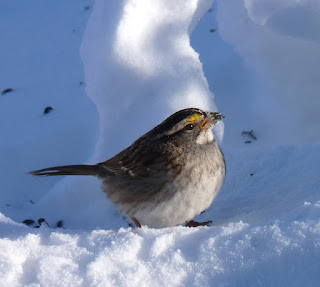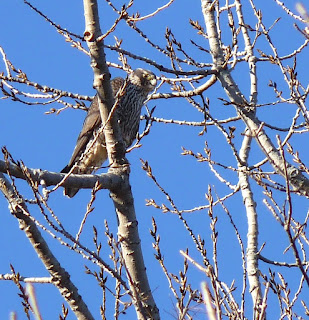 As you can see from my backyard, we had a bit of snow Sunday night into Monday. Portland only had a total of about 10 inches but the wind gusts were strong enough to knock over one of my heavy wooden chairs.
As you can see from my backyard, we had a bit of snow Sunday night into Monday. Portland only had a total of about 10 inches but the wind gusts were strong enough to knock over one of my heavy wooden chairs. I spent most of Monday shoveling snow and making homemade chicken noodle soup but managed to sneak in a little backyard birding. I set up a simple blind by hanging an old blanket over my breezeway door and putting a piece of cardboard in the window with a hole cut out for the camera lens. Surprisingly, we didn't have a lot of bird activity. There were lots of juncos, 1 Carolina Wren, 1 Mourning Dove, 1 Downy Woodpecker, 2 Northern Cardinals, and a few White-throated Sparrows. Normally, I see a lot of birds at the feeders during a snowstorm.
I spent most of Monday shoveling snow and making homemade chicken noodle soup but managed to sneak in a little backyard birding. I set up a simple blind by hanging an old blanket over my breezeway door and putting a piece of cardboard in the window with a hole cut out for the camera lens. Surprisingly, we didn't have a lot of bird activity. There were lots of juncos, 1 Carolina Wren, 1 Mourning Dove, 1 Downy Woodpecker, 2 Northern Cardinals, and a few White-throated Sparrows. Normally, I see a lot of birds at the feeders during a snowstorm.  I set up branches for the birds to land on but they always seemed to land in a position where they were obstructed by other branches or were facing in the wrong direction. I know there are certain methods to control the way the birds land so that is something I'll work on in the future. At least the White-throated Sparrow cooperated by landing in the snow near the window blind. They breed mostly in Candada but I look forward to their return to Connecticut each year in the late Fall.
I set up branches for the birds to land on but they always seemed to land in a position where they were obstructed by other branches or were facing in the wrong direction. I know there are certain methods to control the way the birds land so that is something I'll work on in the future. At least the White-throated Sparrow cooperated by landing in the snow near the window blind. They breed mostly in Candada but I look forward to their return to Connecticut each year in the late Fall. It's interesting how different a bird can look when it changes it's posture. This photo is of the same bird as in the previous photo but it looks a lot taller in this photo. There are two different forms of the White-throated Sparrow. There is a tan-striped form and the white-crowned form seen in these photos. I think the white-crowned form are more striking to look at. I learned this interesting fact at whatbird: "Individuals almost always mate with a bird of the opposite morph. Males of both color types prefer females with white stripes,and both kinds of females prefer tan-striped males."
It's interesting how different a bird can look when it changes it's posture. This photo is of the same bird as in the previous photo but it looks a lot taller in this photo. There are two different forms of the White-throated Sparrow. There is a tan-striped form and the white-crowned form seen in these photos. I think the white-crowned form are more striking to look at. I learned this interesting fact at whatbird: "Individuals almost always mate with a bird of the opposite morph. Males of both color types prefer females with white stripes,and both kinds of females prefer tan-striped males." Don't worry, I didn't set up a secret snow trap just to get this photo. Little birdy did it all on his own.
Don't worry, I didn't set up a secret snow trap just to get this photo. Little birdy did it all on his own.I hope everyone had a Merry Christmas and I want to wish you all a Happy New Year!












































